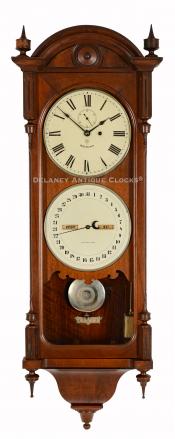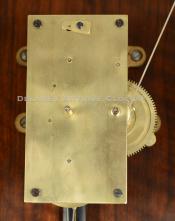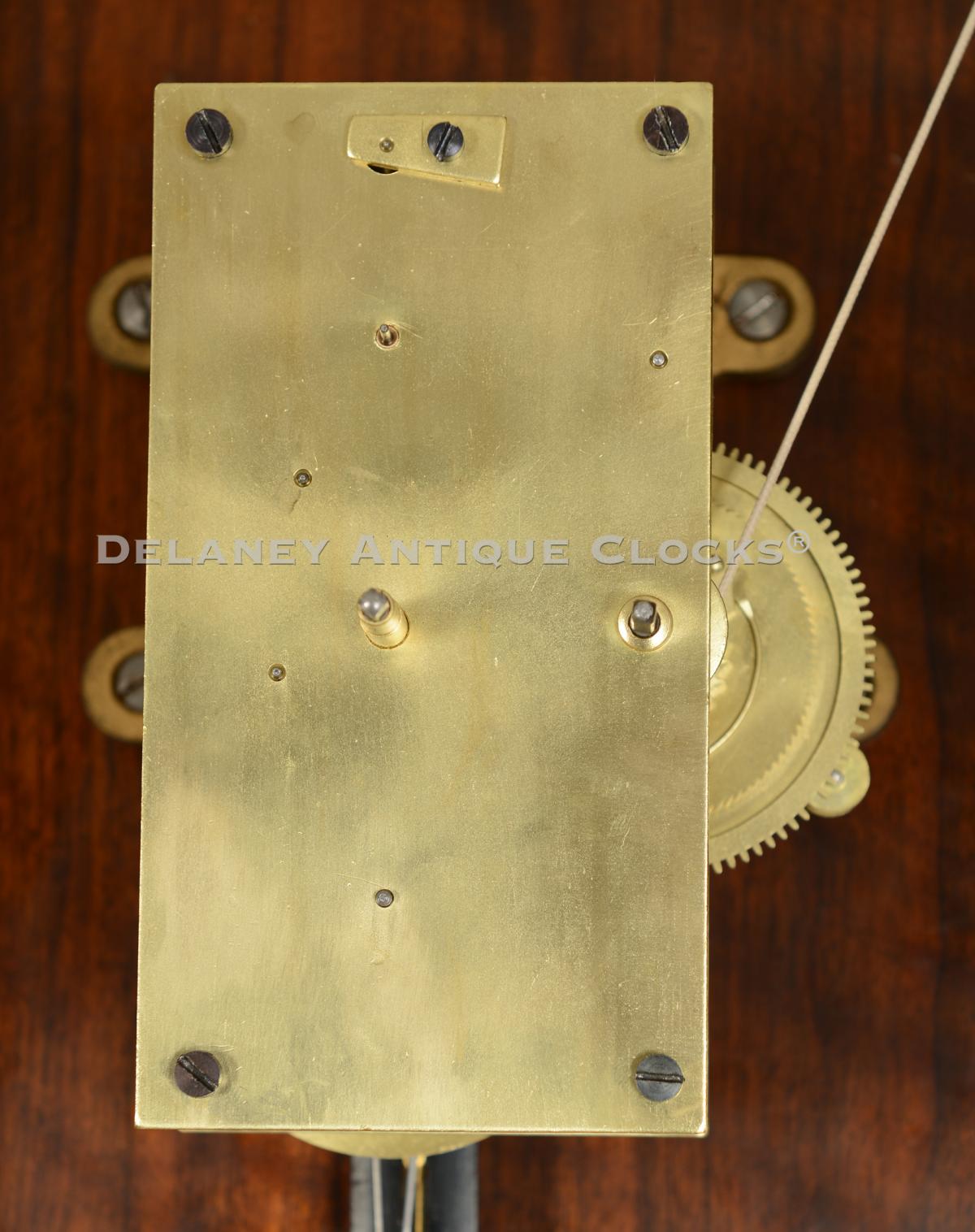Seth Thomas Office Calendar No. 10 in cherry. A double dial wall clock. 223046.
The Seth Thomas Clock Company of Thomaston, Connecticut, made this attractive wall clock. Seth Thomas cataloged this model as the "Office Calendar No. 10," and it was first offered in 1884 in four wood choices. These included walnut, cherry, oak, or old oak. The case form was updated in 1904 due to a change in the positioning of the calendar dial. The revised form presented the calendar dial directly under the time dial. As a result, the pendulum bob was visible in the bottom section of the case.
The example offered is the latter model. This clock is in outstanding original condition. The case is constructed in a walnut case and retains its original finish. Five wooden-turned finials are used to decorate the case. These are all original to this example. Both dials measure 10 inches in diameter and are painted on zinc. These are also in excellent original condition. The upper dial features the Maker's trademark and name painted in the appropriate location. The time track is set up in the traditional Roman hour numeral format. The minute track is closed and runs along the outside of the dial. A subsidiary seconds dial is located below the hour XII. The lower dial displays the calendar information. The days of the month are located on the dial's perimeter in an Arabic format. The calendar patent date information is painted on this dial, "Patented Feb. 15, 1876." This is easy to read. The days of the week and the months are printed on paper rolls. These are in excellent condition. Both dials are trimmed with a nickled ring and set in a walnut wood mask board.
The two movements are located behind the dials. This brass weight-driven movement features long rectangular plates. The original cast iron paint-decorated weight hangs from a cord that threads through a pulley mounted to the upper right side of the case. This provides enough drop for the clock to run for eight days on a full wind. This movement also features maintaining power. The works are mounted to the backboard via a cast iron mounting bracket. This bracket provides enough space for the pendulum to be mounted to the back of the works. The pendulum is long enough that the engraved nickel pendulum bob is partially visible in the lower section of the case. The calendar mechanism, patented by Randall T. Andrews Jr., is mounted below the time works. It gets its change orders from the time movement above. The calendar mechanism is perpetual. This means that when it is set up correctly, it will automatically adjust for the variations in the lengths of the twelve months and changes for the leap year. This mechanism is supported by a bracket that is attached to the backboard.
It is interesting to note that the Seth Thomas Clock Company also used this case form for their Regulator No. 6. In the Calendar form, This clock seldom comes to the marketplace. In 1904, this clock was priced at $40 in their catalog.
The case measures 49 inches long. It is 16.75 inches wide and 6.5 inches deep.
Inventory number 223046.
Seth Thomas was born in Wolcott, Connecticut, in 1785. He was apprenticed as a carpenter and joiner and worked building houses and barns. He started in the clock business in 1807, working for clockmaker Eli Terry. Thomas formed a clock-making partnership in Plymouth, Connecticut, with Eli Terry and Silas Hoadley as Terry, Thomas & Hoadley. In 1810, he bought Terry's clock business, making tall clocks with wooden movements. Seth chose to sell his shares in the partnership in 1812, moving in 1813 to Plymouth Hollow, Connecticut, where he set up a factory to make metal-movement clocks. In 1817, he added shelf and mantel clocks. By the mid-1840s, He successfully transitioned to brass movements and expanded his operations by building a brass rolling mill and a cotton factory. In 1853, He incorporated the business but continued to be the majority shareholder. This clock business expanded until it became one of the "BIG Seven" in Connecticut. Their product line had offerings that competed at every price point, from kitchen clocks to precision regulators. Seth Thomas died in 1859. The community of Plymouth Hollow so revered him that they changed the name on July 6, 1875, to Thomaston in his honor. After his death, his son, Aaron, took over the company's leadership. Aaron is credited with increasing the business by adding a number of new case styles and improving production methods. The company went out of business in the 1980s.
















